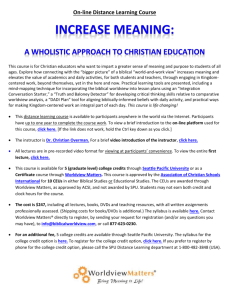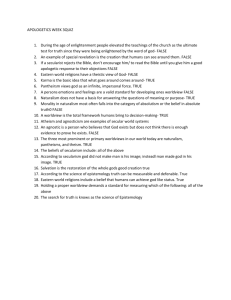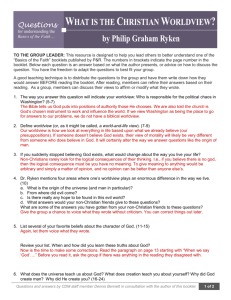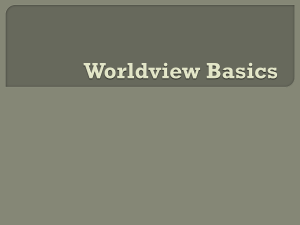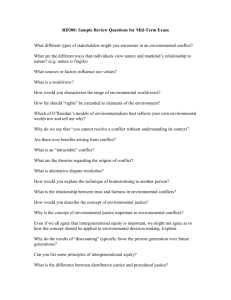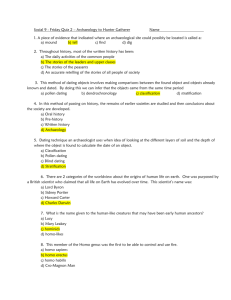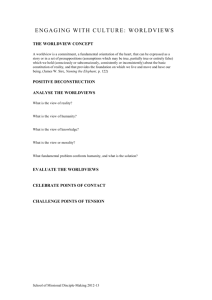ALLIANCE THEOLOGICAL SEMINARY
advertisement
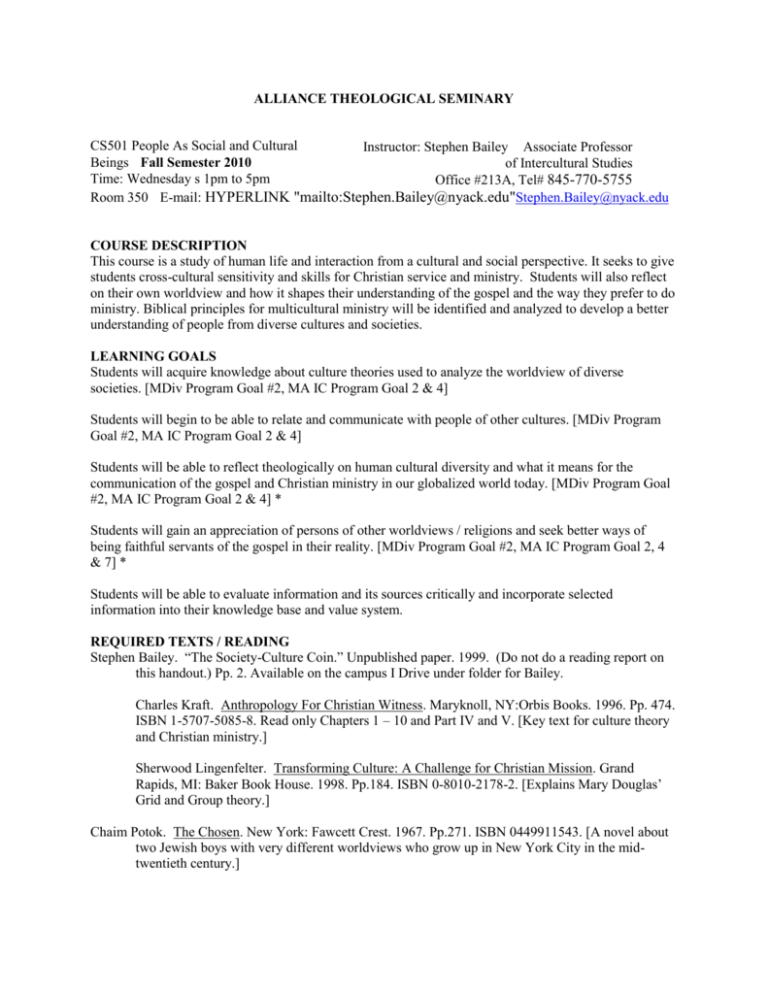
ALLIANCE THEOLOGICAL SEMINARY CS501 People As Social and Cultural Instructor: Stephen Bailey Associate Professor Beings Fall Semester 2010 of Intercultural Studies Time: Wednesday s 1pm to 5pm Office #213A, Tel# 845-770-5755 Room 350 E-mail: HYPERLINK "mailto:Stephen.Bailey@nyack.edu"Stephen.Bailey@nyack.edu COURSE DESCRIPTION This course is a study of human life and interaction from a cultural and social perspective. It seeks to give students cross-cultural sensitivity and skills for Christian service and ministry. Students will also reflect on their own worldview and how it shapes their understanding of the gospel and the way they prefer to do ministry. Biblical principles for multicultural ministry will be identified and analyzed to develop a better understanding of people from diverse cultures and societies. LEARNING GOALS Students will acquire knowledge about culture theories used to analyze the worldview of diverse societies. [MDiv Program Goal #2, MA IC Program Goal 2 & 4] Students will begin to be able to relate and communicate with people of other cultures. [MDiv Program Goal #2, MA IC Program Goal 2 & 4] Students will be able to reflect theologically on human cultural diversity and what it means for the communication of the gospel and Christian ministry in our globalized world today. [MDiv Program Goal #2, MA IC Program Goal 2 & 4] * Students will gain an appreciation of persons of other worldviews / religions and seek better ways of being faithful servants of the gospel in their reality. [MDiv Program Goal #2, MA IC Program Goal 2, 4 & 7] * Students will be able to evaluate information and its sources critically and incorporate selected information into their knowledge base and value system. REQUIRED TEXTS / READING Stephen Bailey. “The Society-Culture Coin.” Unpublished paper. 1999. (Do not do a reading report on this handout.) Pp. 2. Available on the campus I Drive under folder for Bailey. Charles Kraft. Anthropology For Christian Witness. Maryknoll, NY:Orbis Books. 1996. Pp. 474. ISBN 1-5707-5085-8. Read only Chapters 1 – 10 and Part IV and V. [Key text for culture theory and Christian ministry.] Sherwood Lingenfelter. Transforming Culture: A Challenge for Christian Mission. Grand Rapids, MI: Baker Book House. 1998. Pp.184. ISBN 0-8010-2178-2. [Explains Mary Douglas’ Grid and Group theory.] Chaim Potok. The Chosen. New York: Fawcett Crest. 1967. Pp.271. ISBN 0449911543. [A novel about two Jewish boys with very different worldviews who grow up in New York City in the midtwentieth century.] Mark Andrew Ritchie. Spirit of the Rainforest: A Yanomamo Shaman’s Story. Island Lake, IL: Island Lake Press. 1996. ISBN 0-9646952-1-9. [Story of a Yanomamo Shaman’s conversion to Christianity.] If you have already read Spirit of the Rainforest at an early time then read the book listed below instead. Colin M. Turnbull. The Mountain People. NY: Simon & Schuster. 1972. Pp.295. ISBN 0-671-64098-0. [Turnbull’s description of the Ik people, an incredibly poor society.] COURSE CORRELATION CS501 is fitted into the PEOPLE PHASE of the ATS Ministry Formational Model. This course is intended to help students understand the impact of culture on the way humans experience and know God. ASSESSMENT RESULTS ATS may use assignments that are assessed for this course for program evaluation purposes. Individual results may be used as exemplars but will only be available to the program reviewers and not made public. Results of assessments will be used to show program effectiveness and evaluated for program improvement. MDIV PROGRAM GOALS ADDRESSED 2. Students will gain knowledge and be able to apply methodology in biblical studies, theology and cultural understandings. MA IC PROGRAM GOALS ADDRESSED The student will understand and be able to identify the missional themes in the Bible and trace their theological importance to the task of world evangelization. The student will understand, experience and gain skill through the practice of crosscultural communication. The student will gain an appreciation for people from other ethnic and cultural backgrounds and for the unique way God incarnates His Message among the diverse people groups of our world. NYACK CORE GOALS ADDRESSED Nyack | Alliance Theological Seminary seeks to exalt Jesus Christ and fulfill its mission by being: Socially Relevant -- Preparing students to serve in ministerial, educational, healing and community-building professions. Academically Excellent -- Pursuing academic excellence in the spirit of grace and humility. Globally Engaged -- Fostering a global perspective within a multi-ethnic and multicultural Christian academic community. Intentionally Diverse -- Providing educational access and support to motivated students from diverse socioeconomic backgrounds. Personally Transforming -- Emphasizing the integration of faith, learning and spiritual transformation. REQUIREMENTS/GRADING Attendance in each class is expected. The instructor expects that students will be attentive and prepared to discuss the issues scheduled for consideration. There are no excused absences so be sure to sign the attendance sheet for each class session. This requirement is 10% of the grade. [Learning Goals 1-3] Grading Rubric - Based on Attendance Sheet (if you are more than 1 and a half hours late please do not mark yourself present.) Response Sheets on Kraft – Each student will write ten response papers, one page (only) each (see Appendix A for the form to use) on the first ten chapters in the book by Kraft. You are to read Chapters 1 – 10, 13, 15, 16, 18, 19, 23, 24, 25, 26 and 27 but only do response papers for the first ten chapters. See the class schedule for the due dates for each reading and response sheet. Submit a written statement in class stating what percentage of the last ten chapters you were able to read before the last day of the semester. This requirement represents 10% of your grade. [Learning Goal 1&3] Assessment Summary of Key Ideas in Each Chapter = 80% Raises key issues/questions related to ministry/theology = 20% You will write a Book Review on the Lingenfelter book. It will be a two-page review (not longer!). The reviews should include the following (see the sample Appendix B). This requirement is 5% of the grade. [Learning Goal 1, 3 & 4] Grading Rubric The purpose of the book and a summary of the main points of the book on the first page and part of the second page. 80% On the latter part of the second page critique the book briefly and describe how you feel the reading interacts with your present or anticipated ministry context. 10% Formatting / Spelling / Clarity of Writing 10% Worldview Analysis Paper on The Chosen. Write a 5 – 6 page paper (do not exceed this maximum!) describing the worldview of the communities of the two main characters. To do this they will use Charles Kraft’s worldview universal categories as described in class. However, you should analyze the category of Relationship as Bailey defines it in the Power Point slides and not as Kraft defines it. This assignment is 15% of the grade. [Learning Goal 1&3] Due Grading Rubric Analyze each group’s assumptions about Person/Group, Relationship (as defined in class not in the book), Causality, Time and Space (not Classification). When you write the paper make a section for each category, present your data that supports your conclusion about each category keeping the Power Point slides in mind. 70% Describe the worldview change that the main characters go through in a clearly labeled section of the paper. 10% Compare your own worldview in contrast to the worldviews of these two groups in terms of your assumptions for each of the WV universal categories. 10% Formatting / Spelling / Clarity of Writing 10% Grid / Group Worldview Book Report Write a 3-4 page paper on The Spirit of the Rainforest. Be sure to read the Lingenfelter book and the Power Point Slides on Mary Douglas before writing this paper. This paper represents 10% of your grade. [Learning Goal 1, 3 & 4] Due on Grading Rubric Briefly analyze the group and grid levels of the Yanamamo using the data presented in the book. Create and label one section for the grid data and one for the group data. State your conclusion and give evidence for your decision. 60% Determine the group’s cosmology comparing the characteristics that these cosmologies are said to have (in class and in Lingenfelter) with what you found in the book. 30% Formatting / Spelling / Clarity of Writing 10% 1st Field Report - Write a 5 to 6 page field report reflecting on the worldview of a person from a different culture (and one that you know little about). (For instance, if you are of Asian descent you may not interview another Asian person. You must interview someone from Africa, Central or South America.) The person you interview cannot be someone you know and must be a non-Christian. The person should have lived in the USA (preferably) for less than two years. You must conduct at least two hours of interviews with this person. It is best to do this over two or three shorter interviews. It will be necessary to spend some time before the interviews to think through indirect ways of asking questions about worldview. Direct questions about worldview do not work well. This requirement will be counted as 25% of the grade. [Learning Goal 1, 2 & 3] * Grading Rubric Background: Start the paper by briefly describing the interviewee’s background, age, gender, etc. Also state where, and for how long, you interviewed the person. 10% of grade Analyze (draw conclusions about) and describe their worldview in terms of each of Kraft’s worldview universals of Person-Group, Space, Time, Relationship and Causality as defined and discussed in class. Create a section in the paper for each Worldview Category showing your evidence for the conclusions you draw for each one. Do not simply describe what the person said or give me your field notes. You are to analyze – draw conclusions and give data only to support these conclusions. 60% of grade Describe how your worldview differs from the worldview of the person you interviewed and observed. 10% of grade Describe how your analysis of their worldview should shape the way you would communicate the gospel to them. I am not interested in what you would say to them but in how you would relate and communicate with them. Describe how you would do this with your conclusions for each of the worldview categories in mind. 10% of grade Formatting / Spelling / Clarity of Writing 10% of grade 2nd Field Report – Students will write a 5-6 page paper after visiting two local churches that represent different social contexts, which they have never attended before and which represent a different cultural group than their own. This requirement will be counted as 25% of the grade. [Learning Goal 1, 2 & 3] Directions for Assignment Gathering Your Data – most of your data can be collected through observation for this paper. Observe and Participate in one or two worship services. Interview - Conduct interviews with the pastor (if possible) and lay people from the church that will clarify what you have observed. Carefully consider and prepare your questions beforehand. Use indirect questions and ask the same question in different ways if possible. Determine the Level of Grid / Structure in the group observe the following: Are there lots of symbols and rituals used to externalize faith? Is there a lot or a little structure in worship? Is the communication style and dress style formal or informal? Are roles easily swapped? Do the roles significantly impact the person’s behavior? Is the Church government structure highly structured and carefully followed or is it loose and not fully implemented? How are decisions made? Now draw a conclusion of whether you consider this a high or low grid society. Review the preferences of high grid societies that were shared in class (review your class notes on Mary Douglas), do you see evidence of these preferences in the group? Determine the level of Group in the group observe the following: How close do people sit together? Do people dress alike? Is the worship response of the people coordinated? Does everyone know each other? Do they come from the same ethnic / national / social background? Do they use a language other than English in their worship? How often do they gather as a church? Do they socialize together as well as worship together? Are there a lot of people coming and going that never seek formal membership? Are they comfortable with ecstatic experiences in the Holy Spirit? Do they communicate directly or indirectly? Are they open to outsiders? Now draw a conclusion of whether you consider this a high or low group society. Before you do review the preferences of high group societies that were shared in class (review your class notes on Mary Douglas), do you see evidence of these preferences in the group? Determine the Cosmology of the Group Now that you have decided the level of grid and group in the church what cosmology or social game would you ascribe to them? Does your conclusion regarding their cosmology and the preferences that go with that cosmology fit with your data (observations made of the behavior of those in the church)? If most of the data seems to fit this church you are probably on the right track but if not then you should rethink your data in light of a different cosmology. Did you analyze the level of grid and group correctly? If a few things don’t seem to be relevant to the cosmology you chose, your decision might still be correct. Assessment Background: Start your paper with a short introduction describing the church – its name, denomination, where it is, size, etc. 10% of the grade Clearly state what cosmology you feel the church follows and your conclusions as to the level of grid and group. Describe the levels of grid and group in terms of data presented under the following categories: Communication style Leadership style / structure Worship style – especially how the group relates to the Holy Spirit Use of ritual and symbol Theme for salvation – see class notes This part should show your understanding of grid and group theory and your ability to apply it to a local church setting. 70% of the grade Evaluate whether or not you feel the cosmology that shapes the church’s communication, worship and organization matches what you see in the congregation. Does the ministry of this church seem right for the people they are trying to reach with the gospel? Suggest a strategy for improving the overall communication aspect of the church’s ministry. Focus on how you would work to adjust the levels of grid and group in the Church worship, leadership and communication style to match the social experience of the people attending and in the community the church is trying to reach. 10% of the grade Formatting / Spelling / Clarity of Writing 10% of the grade EVALUATION Class Attendance 10% Kraft Response Sheets 10% 1st Field Paper 25% Potok WV Paper 15% Lingenfelter Bk Rpt 5% Grid/Group Bk Rpt 10% 2nd Field Paper 25% GRADING SCALE Grades are based on your competency in performing the assignments referred to in this syllabus. A (4.0) 93-100 A- (3.7) 90-92 B+ (3.3) 88-89 B (3.0) 83-87 B- (2.7) 80-82 C+ (2.3) 78-79 C (2.0) 73-77 C- (1.7) 70-72 D+ (1.3) 68-69 D (1.0) 63-67 D- (0.7) 60-62 F (0.0) Below 60 LATE WORK All written work is due by the beginning of class on the date assigned. The Professor reserves the right to not accept work that is more than two weeks late. Work that is turned in late will be penalized 1 point for each day late. IMPORTANT NOTES All written assignments should be formatted according to Turabian’s formatting rules. A summary of these rules is available on the campus I Drive. All assignments are due on the date indicated in the class schedule below unless otherwise indicated by the professor in class. Students should keep copies of all handed in assignments and keep track of their own grades throughout the semester. All the class notes will be on the I: Drive. You may access the Instructional Drive with your login (last name followed by first letter of you first name) and password (last four digits of your SS#) COURSE CALENDAR Week 1 / September 8 Assignment Due – All the Kraft Reading and Response Sheets (10), Lingenfelter Paper Read - Stephen Bailey. “The Society-Culture Coin.” Introduction of Syllabus and Text Books Topic: What is Culture? Week 2 / September 15 Reading – Response sheets on Kraft reading Assignment Due –Reading Due – Kraft Chapter 1-3 and 5 Topic: Gaining A Cross Cultural Perspective Week 3 / September 22 Assignment Due – Response sheets on Kraft reading Reading Due – Kraft Chapter 6-10 Topic: Worldview and WV Universals Week 4 / September 29 Assignment Due – Response sheets on Kraft reading Reading Due – Kraft Chapter 4 Discovering Worldview Universals: Ethnography Week 5 / October 6 / John Ellenberger Visiting Professor Assignment Due – None Reading Due – The Chosen Topic: Topic: Worldview Case Studies / Video on Yanamamo The Feast Week 6 / October 13 Assignment Due – Paper on The Chosen, Work on your field Interviews Reading Due – The Chosen Topic: Moral Relativism and the Gospel / The Chosen Week 7 / October 20 Assignment Due – None Reading Due – Lingenfelter Topic: Form, Meaning and Symbols Week 8 / October 27 Assignment Due – Book review on Lingenfelter Reading Due – Lingenfelter Topic: Introducing Mary Douglas: Grid and Group Analysis Week 9 / November 3 Assignment Due – None Reading due – continue reading Lingenfelter Grid and Group: The Four Cosmologies Week 10 / November 10 Assignment Due – 1st Field Observation / Interview Paper Due Reading Due – None Topic: Grid and Group for Ministry Week 11 / November 17 Assignment Due – None Reading Due – Kraft 13, 15, 16, 18 Topic: Small Group Grid / Group Analysis From Ethnographies 4 People Groups via Video THANKSGIVING BREAK Week 12 / December 1 Assignment Due – Worldview Book Paper Reading Due – Worldview Book Spirit of the Rainforest or The Mountain People Topic: The Physical and Social Body and Leviticus: Mary Douglas Doing Theology in Context Week 13 / December 8 Reading Due – Kraft 19, 23, 24, 25, 26, 27 Assignment Due: 2nd Field paper / Grid and Group Analysis of 2 Churches Topic – 4 Styles of worship / Kelvin Walker, Jen Otterbein to lead class Week 14 / December 15 Reading Due – None Topics: Doing Theology in Context Class Evaluation RESPONSE SHEET Research and Study Name: Pages Read: Date: PO Box#__________ 1. Summarize the Chapter’s Key Points 2. What questions do you have with regards to the content of this chapter? Your e-mail address here Your Box # Here Allen, Roland 1962 The Spontaneous Expansion of the Church. Grand Rapids, MI: Wm. B. Eerdmans Publishing Company. An Anglican and a high churchman, Roland Allen was a missionary with the Society for the Propagation of the Gospel in northern China from 1895 to 1903. His best known book is, Missionary Methods: St. Paul’s or Ours?, but The Spontaneous Expansion of the Church, is considered a more mature explanation of many of the themes he addressed in that earlier book. It was not until the 1960s that Allen’s work was read widely and given the forcefulness of his critique of the western missionary effort, this is not surprising. Allen’s central thesis is that the Church planted around the world by the western missionary effort is far too often a Church which is “essentially foreign” in nature. In presenting this thesis he describes the characteristics of the spontaneous expansion of the Christian Church, the reasons (or fears) which prohibit spontaneous expansion and debates a number of arguments against removing the restraints on establishing truly free local churches. Finally, Allen suggests a means of dealing with the many churches which are already established in patterns of dependency on westerners. Allen believes that a truly free church will naturally grow. He describes spontaneous expansion as, expansion which follows the unexhorted and unorganized activity of individual members of the Church explaining to others the Gospel which they have found themselves; I mean the expansion which follows the irresistible attraction of the Christian Church for men who see its ordered life, and are drawn to it by desire to discover the secret of a life which they instinctively desire to share; I mean also the expansion of the Church by the addition of new churches (p.7). The primary causes for the restriction of the growth of the Church are the fear of untrained local leadership teaching incorrect doctrine, the fear that locally led churches will not maintain high moral standards, the desire of western missionaries to “civilize” those they are evangelizing with western education and development work, and the hiring and training of local Christians to work under the authority of foreign missionaries and their structures (rather than allowing them to do this spontaneously and independently). At a theological level Allen is calling for a Spirit led church growth rather than organizationally planned and controlled growth. The latter he equates with ministering under the law as opposed to under the Spirit in the apostolic fashion. At the level of social theory I feel he is struggling with the sodality modality tension. While his critique is penetrating it is at the same time possible to understand that he did not fully come to terms with the inevitable tendency for all social movements to become bureaucratic. Having said that I hasten to add that his critique is one that none of us can ignore and need to keep constantly in view as we go about our mission effort. Allen’s insights are crucial to my study of worldview issues for communicating the gospel to Lao people. It unmasks the worldview assumptions of foreign missionaries (now western and otherwise) that hinder the advance of the gospel. Among the most telling are his insight into western culture's deep trust in organizational efforts which are financially (revealing our deep seated capitalist value system) and bureaucratically structured; the psychological destruction of the confidence of local believers by replacing untrained local lay people who have started local churches; our constant battle as missionaries with feelings of spiritual and cultural superiority; and his declaration that there is no moral standard given in scripture that stands for all time and all cultural circumstances (p.68). PAGE \* MERGEFORMAT 11 APPENDIX A APPENDIX B Sample format for Lingenfelter Paper APPENDIX C
